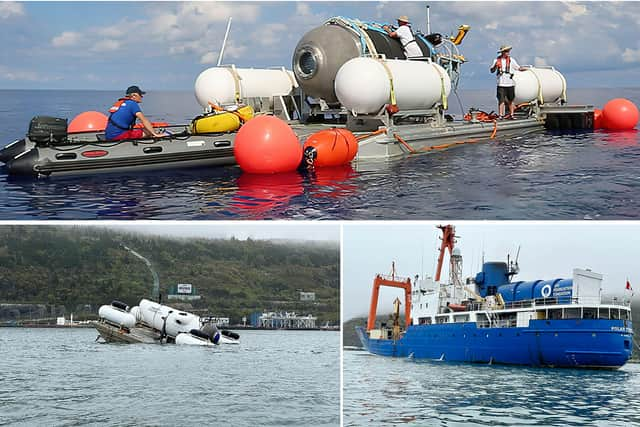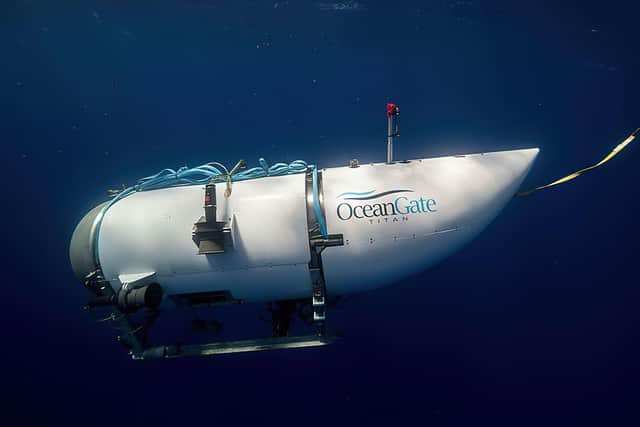Missing Titanic submarine: rescuers face extreme challenges in 'complex and unusual' recovery operation
and live on Freeview channel 276
A deep water search-and-rescue expert says he is “very worried” by a missing submersible with less that two days of air left, as a journalist who has previously taken the trip claims the crew would not be able to free themselves without help.
Rescuers are racing to find a missing submersible that disappeared during a voyage to the Titanic shipwreck, after the vessel was reported overdue on Sunday evening (18 June). As of Tuesday afternoon, it is now believed there are around 40 hours of oxygen left on the Titan - which lost communication with its support boat about 435 miles off the Canadian coast.
Advertisement
Hide AdAdvertisement
Hide AdDavid Mearns, a UK-based marine scientist and oceanographer who specialises in searching for shipwrecks, is friends with billionaire Hamish Harding and knows French diver Paul-Henri Nargeolet professionally - two of the five crewmembers onboard the missing vessel.
Speaking to Lucy Manning on BBC Radio 4’s World At One, he described Mr Harding as “very charming” and “very adventurous”, and said that Mr Nargeolet was “very well known” in the Titanic community.
Search and recovery was his area of expertise, he said, "but when it’s involving people you know personally, the impact of it is bigger". Mr Mearns said when something does go wrong in a submersible and it goes missing, it was a "dire" situation.
"We’re all very very worried and concerned for our friends and the other people on board," he added.
Advertisement
Hide AdAdvertisement
Hide Ad

What do we know about the rescue operation so far?
The US Coast Guard is running the search operation from Boston, supported by military aircraft. On Tuesday, a Canadian aircraft joined the search for the missing submersible, which was capable of using sonar to scan areas below the surface.
“A Canadian Aircraft P3 Aurora has arrived on scene to conduct sonar searches," it said in a Tweet. “The R/V Polar Prince and R/V Deep Energy are continuing their surface searches."
The total area searched as of Tuesday morning was 10,000 square miles, it confirmed. At a press conference on Tuesday afternoon, Coast Guard Captain Jamie Frederick said they had been working "around the clock" to find the sub, but it had been a "complex search" needing specialised equipment, CNN reports.
A number of privately-owned vessels were also en route to join the search operation, while CNN reported an undersea pipe-laying vessel called Deep Energy had started a dive at the sub's last known position, to see what it could find.
Advertisement
Hide AdAdvertisement
Hide AdBBC reports this vessel is remotely operated, but had a camera onboard. Captain Frederick said if it finds something, experts will figure out the "best course of action" from there. He also said weather conditions has improved for aerial searches, with the skies less foggy that Monday.
What challenges does the rescue operation present?
The search and rescue operation in believed to be uniquely challenging, in part due to the depth the submersible was believed to be at.
The vessel's "last ping" before it lost contact with its support vessel was roughly one hour and 45 minutes into its more than two-hour descent, the Mirror reports, and placed it just above the shipwreck site - which is roughly 3,800 metres under the sea.


Dik Barton, the first British diver to ever see the Titanic's ruins, made 22 dives to the wreck to recover artefacts when he was head of operations with RMS Titanic Inc. He told PA the submarine had most likely either lost power on its descent, or its structural integrity at great depth.
Advertisement
Hide AdAdvertisement
Hide AdMr Barton, now a guest lecturer at Sunderland University, said his descents took two-and-a-half hours to reach the seabed site, and two hours to return to the surface. “It’s completely pitch black and then you get to the sea bed, put on your lights and there you are with the Titanic before you, if you land in the right place. It’s not easy, the wreck site is two miles across.”
But Mr Barton said the group had “good leadership” in the pilot, Paul-Henry Nargeolet, who he knew personally. “He is the kind of man who will keep them calm, but it’s not easy in a tube at the bottom of the ocean,” he said.
The UK government was ready to provide support and assistance if needed - including in its capacity as the host nation for NATO’s multinational submarine rescue system. However, the Prime Minister’s official spokesman said it was "a complex rescue mission at significant depth".
“We are in contact with the relevant authorities and are ready to provide assistance, but clearly it is an unusual rescue operation given the depths involved," he continued. “At this stage I’m not aware they’ve specifically requested assistance from our capacity, which is based in Clyde in the naval base there."
Advertisement
Hide AdAdvertisement
Hide Ad'There's no backup, there's no escape pod... It's get to the surface or die'
Journalist David Pogue travelled aboard OceanGate's Titan submersible last year, and told the BBC that while the support ship is directly above the submersible after launching it, the two vessels can send short, text-based messages to one another, but other forms of communication like GPS or radio did not work that far underwater.
He added that it would not be possible for the crew members to escape from the sub themselves either, because they were sealed inside by bolts applied from outside - and had to be freed externally.
The Titan had seven different functions that could let it resurface, he told the BBC, and that it was "really concerning" none of them appeared to have worked in this case. He said some reasons they might not have activated could be if the sub had became trapped somewhere, or had sprung a leak.
"There's no backup, there's no escape pod," he said. "It's get to the surface or die."
Comment Guidelines
National World encourages reader discussion on our stories. User feedback, insights and back-and-forth exchanges add a rich layer of context to reporting. Please review our Community Guidelines before commenting.
